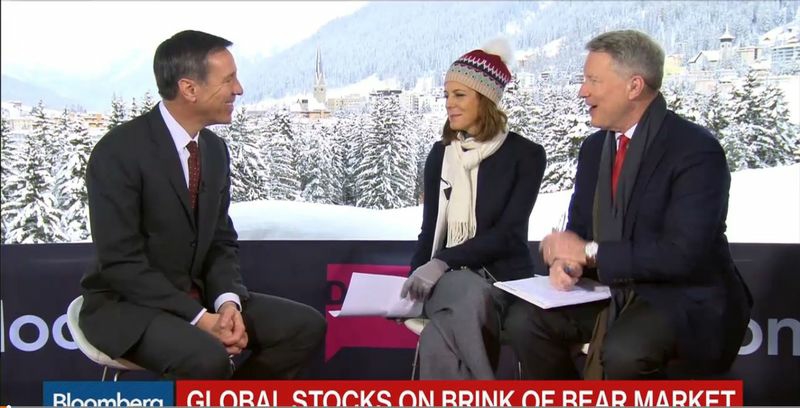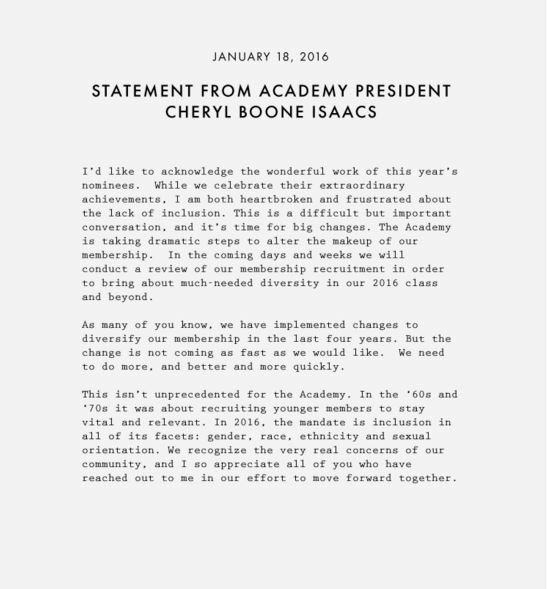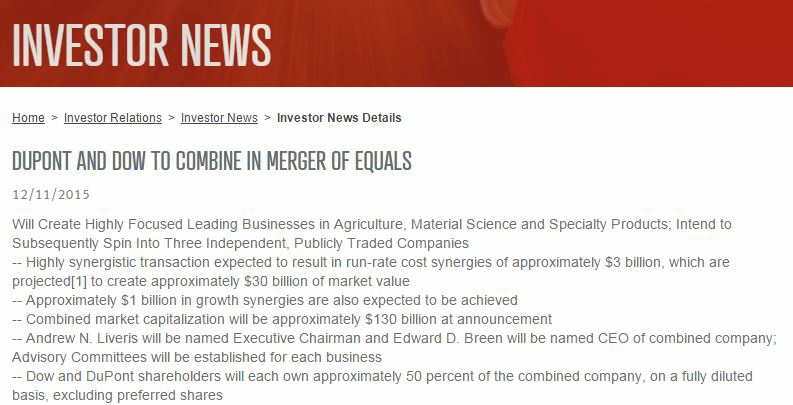The Academy Announces a Plan to Increase Diversity
Shortly after hearing complaints that Oscar nominations are exclusively for white actors, The Academy of Motion Picture Arts and Sciences has responded with a plan to increase diversity.
President Cheryl Boone Isaacs had written a response about the controversy, but it didn't do enough to ease concerns. Actors continued plans to boycott the awards, and Saturday Night Live did a skit showing white actors winning nominations for minor roles, such as mistakenly walking on set.
Now, the organization has identified clearer targets for addressing the main criticism: that the voting members of The Academy (including its executive board) are not diverse enough. The organization's plan includes improving diversity of its governing body, partly by increasing the number of seats available and partly by restricting terms to three years. The time restriction would open the door for younger actors of color who have worked in the business more recently.
Lifetime voting rights reframed; new governor seats added and committees restructured
Goal to double number of diverse members by 2020
In a unanimous vote Thursday night (1/21), the Board of Governors of the Academy of Motion Picture Arts and Sciences approved a sweeping series of substantive changes designed to make the Academy's membership, its governing bodies, and its voting members significantly more diverse. The Board's goal is to commit to doubling the number of women and diverse members of the Academy by 2020.
"The Academy is going to lead and not wait for the industry to catch up," said Academy President Cheryl Boone Isaacs. "These new measures regarding governance and voting will have an immediate impact and begin the process of significantly changing our membership composition."
Beginning later this year, each new member's voting status will last 10 years, and will be renewed if that new member has been active in motion pictures during that decade. In addition, members will receive lifetime voting rights after three ten-year terms; or if they have won or been nominated for an Academy Award. We will apply these same standards retroactively to current members. In other words, if a current member has not been active in the last 10 years they can still qualify by meeting the other criteria. Those who do not qualify for active status will be moved to emeritus status. Emeritus members do not pay dues but enjoy all the privileges of membership, except voting. This will not affect voting for this year's Oscars.
At the same time, the Academy will supplement the traditional process in which current members sponsor new members by launching an ambitious, global campaign to identify and recruit qualified new members who represent greater diversity.
In order to immediately increase diversity on the Board of Governors, the Academy will establish three new governor seats that will be nominated by the President for three-year terms and confirmed by the Board.
The Academy will also take immediate action to increase diversity by adding new members who are not Governors to its executive and board committees where key decisions about membership and governance are made. This will allow new members an opportunity to become more active in Academy decision-making and help the organization identify and nurture future leaders.
Along with Boone Isaacs, the Board's Membership and Administration Committee, chaired by Academy Governor Phil Robinson, led the efforts to enact these initiatives.
Discussion Starters:
- What's your view of The Academy's plan? How well does it address criticism? Would it affect your decision to boycott the awards?
- Why didn't The Academy publish this plan with the first communication? Would that have helped quell some of the controversy?
U.S. Mayors Hear Airbnb Arguments
 American mayors heard arguments about Airbnb's short-term rental business and have to decide whether it's good for their cities. Airbnb argues that the business brings millions of dollars in tax revenue to municipalities. If the company is allowed to continue connecting hosts and guests online, according to Chris Lehane, Airbnb's head of global policy, hotel, tourist and occupancy taxes could mount to $200 million a year.
American mayors heard arguments about Airbnb's short-term rental business and have to decide whether it's good for their cities. Airbnb argues that the business brings millions of dollars in tax revenue to municipalities. If the company is allowed to continue connecting hosts and guests online, according to Chris Lehane, Airbnb's head of global policy, hotel, tourist and occupancy taxes could mount to $200 million a year.
The opposing view at the mayor's conference was led by Katherine Lugar, president of the American Hotel & Lodging Association. According to a Penn State study, many of Airbnb hosts are professional landlords who rent rooms illegally and have made more than $500 million in revenue: "Our data is showing a tremendous growth of commercial operators who are exploiting sites like Airbnb to avoid paying taxes, following zoning rules and following basic laws for health and safety."
Airbnb is working through local organizations to fight restrictions, but short-term rentals have been banned in several municipalities.
Discussion Starters:
- Read the Penn State report. How does it provide evidence for AHLA's point of view? How does it fall short?
- Analyze the graphics used in the report. Which principles of creating infographics from Chapter 9 are used?
"Reply All" Trouble
We can take a lesson from Time Inc.: check before hitting "Reply All." At the largest magazine publishing company in the United States, an employee asked a benefits question that went to thousands of employees. A photo editor inquired about the heath savings plan:
The funny thing is, after reading more, we learn that this is an IT issue, which sent a response email back to the listserv (the entire company). Maybe some of the criticism was unfair. Still, we should check to see where our email goes before sending it. A listserv in the "To" line could be dangerous..
Of course, Time employees made the situation far worse by replying back to everyone with snarky comments:
This brings us to the second lesson: if you get an email like this by mistake, just delete it.
Discussion Starters:
- Have you experienced something similar at work or school? How did you or the company handle the situation?
- What other advice would you offer people before they "hit send"?
Marriott CEO Interview at Davos
Marriott CEO Arne Sorenson told Bloomberg TV at Davos that he's optimistic about the hotel outlook for 2016.
Sorenson uses logical arguments to explain his perspective on rates and bookings despite weak performance in the stock market. Referring to industry data, he makes a convincing case that Marriott will see similar revenue in 2016.
In discussing the Starwood acquisition, Sorenson explains the purchase of equity (and a lower price today than what was announced) and describes plans for the integration mid-2016. He also talks about more potential M&A activity for other hotel companies.
Discussion Starters:
- What examples of logical arguments do you identify in Sorenson's interview?
- What data does he use to support his points?
- Sorenson is realistic. Identify at least three examples of reservations and qualifiers you hear him use. How do these help or hurt his position?
Oscars' (Typewritten?) Response to Lack of Inclusion
Like last year, Oscar nominations from The Academy of Motion Picture Arts and Sciences included not one black actor or filmmaker in the top categories, and people are upset. Spike Lee, Jada Pinkett Smith, and Will Smith and others will boycott the award ceremony in February, and #OscarsSoWhite is trending on Twitter.
The Academy has responded by promising to prioritize diversity for the organization. Much of the criticism is about the make-up of the group itself:
A Los Angeles Times study found that academy voters are markedly less diverse than the moviegoing public, and even more monolithic than many in the film industry may suspect. Oscar voters are nearly 94% Caucasian and 77% male, The Times found. Blacks are about 2% of the academy, and Latinos are less than 2%.
Oscar voters have a median age of 62, the study showed. People younger than 50 constitute just 14% of the membership.
President Cheryl Boone Isaacs, one of two non-white members of The Academy issued this statement in response to the controversy.
Why does the statement look as though it were written on a typewriter? This can't help The Academy's image as a bunch of old, out-of-touch people. Also, I have long stopped double-spacing between sentences based on style guides and this sound advice from PR Daily.
Discussion Starters:
- Assess The Academy's response. How well did Boone address concerns?
- What will you do? If you typically watch the awards ceremony, will you boycott this year? Why or why not? What do you think the actors should do?
More Controversy About Slavery Representation in Books
Last fall, McGraw-Hill was under fire for misrepresenting the history of slavery in the United States. Now, Scholastic publishing company is facing similar criticism about a children's book. 
A Birthday Cake for George Washington focuses on Hercules, the former president's chef, and includes pictures of his slaves smiling. The VP of Scholastic Trade Publishing defended the book in a blog post, excerpted here:
"The topic of slavery is one that must be handled with the utmost care, especially in the form of visual depictions, historical references, dialogue, and characterizations in books for young readers. In A Birthday Cake for George Washington the lives of enslaved people ― and the complex inequities of their bondage ― play a key role in the narrative. Through carefully curated research, A Birthday Cake for George Washington presents an important slice of American history. It is based on the true story of Hercules, the president's cook. Hercules was one of over 300 African Americans enslaved by George and Martha Washington. Even though he was a slave, everyone knew and admired Hercules ― especially the president!"
A Change.org petition called the book a "vile exemplification of the distortion of history" and got 928 signatures as of this writing. It was enough.
Scholastic has since posted a "New Statement" to announce the end of book distribution and to offer refunds for purchased books. The company clearly stands by those who made the book possible, but the management team now recognizes that, "without more historical background on the evils of slavery than this book for younger children can provide, the book may give a false impression of the reality of the lives of slaves and therefore should be withdrawn."
Discussion Starters:
- Read the first blog post defending the book. What are the strongest and weakest arguments?
- Did Scholastic make the right decision in pulling the book?
T-Mobile Letter: "Binge On!"
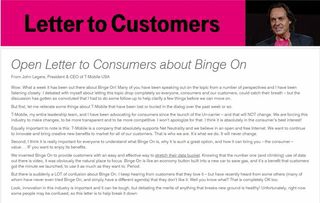 T-Mobile announced "Binge On," a new program for consumers to "stretch their data bucket." The service allows customers to watch videos at lower resolutions (which the company says doesn't matter on small screens) and not count the time against their high-resolution data minutes. In addition, consumers can watch videos from partner sites for free.
T-Mobile announced "Binge On," a new program for consumers to "stretch their data bucket." The service allows customers to watch videos at lower resolutions (which the company says doesn't matter on small screens) and not count the time against their high-resolution data minutes. In addition, consumers can watch videos from partner sites for free.
Not all responses to Binge On have been positive. The Electronic Frontier Foundation (EFF) has questioned whether the program affects streaming in addition to bandwith. In a video tweet response, CEO John Legere shot back a response including the F-bomb. Legere later apologized.
In a letter to customers, Legere clarifies that the service is "opt-in" (a big concern) and explains the program in more detail. This paragraph is an example of Legere's usual, casual style:
But there is suddenly a LOT of confusion about Binge On. I keep hearing from customers that they love it – but have recently heard from some others (many of whom have never even tried Binge On, and simply have a different agenda) that they don't like it. Well you know what? That is completely OK too.
My sister sent me the letter and didn't appreciate the casual tone or the "creepy" picture of the CEO. She also noted that the letter isn't dated, so it's unclear when all of this happened.
Consumers can find more information on T-Mobile's FAQs about Binge On.
Discussion Starters:
- What's your view of Legere's writing style? Partly, it fits with the T-Mobile image, but is it too much for customers?
- Could T-Mobile have avoided some of the controversy with clearer communications during the rollout? What do you think happened, and how could the messaging have been handled differently?
Ted Cruz on Hot Seat for Campaign Funds from GS
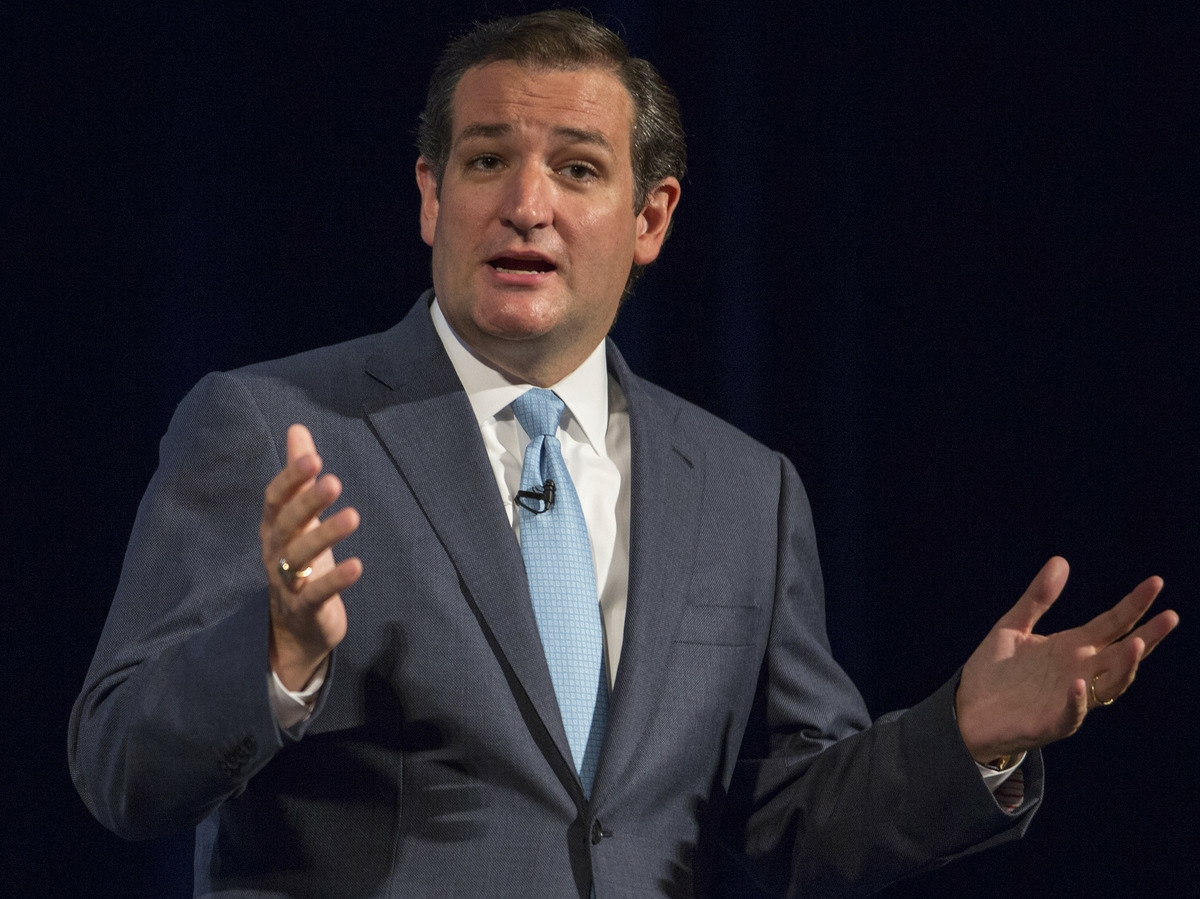 Republican presidential candidate Ted Cruz didn't disclose a loan he received from Goldman Sachs for his campaign. He was a managing director at the investment bank before taking a leave to run for president.
Republican presidential candidate Ted Cruz didn't disclose a loan he received from Goldman Sachs for his campaign. He was a managing director at the investment bank before taking a leave to run for president.
Campaign rules dictate that candidates reveal all sources of income for a bid for office, including loans. He received between $250,000 and $500,000 from GS as a low-interest loan at the start of his campaign. Cruz's campaign is trying to explain the failure as "inadvertent" (I was waiting for "an oversight"), saying that he did disclose a money market account that included the GS loan and another from Citibank.
Particularly troubling for Cruz is the contrast between this news and how he presented himself and his wife. He spoke in interviews about their decision to use all of their liquid savings, about $1 million, for his campaign. Yesterday, The Wall Street Journal quoted Cruz saying he wouldn't bail out "rich Wall Street banks." As the candidate tries to distance himself from Wall Street, his ties are closer than he admits.
A New York Times article also questions whether the decision with his wife happened as he described it (that she immediately agreed) and whether they did, in fact, use all of their assets:
During 2012, they sold securities worth $82,000 to $355,000, and the value of other holdings was reduced by, at most, $155,000. . . All told, the value of their cash and securities in 2012 saw a net increase of as much as $400,000 - even as the Cruzes were supposedly liquidating everything to finance Mr. Cruz's Senate campaign."
Discussion Starters:
- Is this nit picky, or does Ted Cruz has some real explaining to do?
- How, if at all, do you think this will affect Cruz's campaign? Marco Rubio and Hillary Clinton also faced financial questions, yet the criticism seems to have blown over.
- What else, if anything, should the Cruz campaign say at this point? Should Cruz issue a statement himself?
Another Call for Hope in Obama's Last SOTU
President Obama's presidency came full circle in his last State of the Union (SOTU) address. The speech was not without humor. The president began by promising to keep it short, so people could get back to Iowa for more campaigning. (Transcript)
As expected, the president highlighted accomplishments from his administration and laid out plans for the future. The speech sounded optimistic, which of course, was the theme of his first presidential campaign. He ended this way:
That's the America I know. That's the country we love. Clear- eyed, big-hearted, undaunted by challenge, optimistic that unarmed truth and unconditional love will have the final word. That's what makes me so hopeful about our future.
I believe in change because I believe in you, the American people. And that's why I stand here, as confident as I have ever been, that the state of our Union is strong.
 The audience reaction is typical and always baffles me: Republicans don't support anything a Democratic president says, and the opposite happens when we have a Republican president. It's strange to me when the President makes some points that, surely, everyone agrees with. Early on, he says, "First, how do we give everyone a fair shot at opportunity and security in this new economy?" The camera is on Marco Rubio, who sits stoically in non-response. Doesn't he support opportunity for everyone?
The audience reaction is typical and always baffles me: Republicans don't support anything a Democratic president says, and the opposite happens when we have a Republican president. It's strange to me when the President makes some points that, surely, everyone agrees with. Early on, he says, "First, how do we give everyone a fair shot at opportunity and security in this new economy?" The camera is on Marco Rubio, who sits stoically in non-response. Doesn't he support opportunity for everyone?
As usual, major newspapers showed their political bent in reporting on the SOTU. The Wall Street Journal ran a secondary headline on the front page with the title, "GOP Candidates Contrast Obama's Speech With Their Own Aims." The Journal showed additional stories under the "Politics" heading further down on the site, shown here.
In contrast, The New York Times ran the story as the main headline of the day with the title, "Obama Offers Hopeful Vision While Noting Nation's Fears," and ran more stories, including opinions, with positive titles about the speech.
Discussion Starters:
- What do you consider to be the highlights of President Obama's speech?
- Look at the audience's reactions. What's your view of the convention I mention above: how does the non-response serve each side?
The #$@&%*! Golden Globes
I cut the cable cord three years ago, so I missed all of the cursing during the Golden Globes, but the language is making headlines. Comedian Amy Schumer set the stage with the first cuss word of the night (beginning with a C), according to Daily Mail, "just minutes after the show got underway."
Host Ricky Gervais continued the evening with his usual vitriol, despite saying several times,"I'm going to be nice tonight," which of course, no one expected or wanted. He started his opening monologue, drinking a glass of beer, by telling the crowd to "Shut up." In about seven minutes, Gervais insulted Caitlyn Jenner, Jeffrey Tambor, Roman Polanski, Jennifer Lawrence, and the film companies in general. The worst insults flew to Mel Gibson later on.
The F-bombs continued throughout show, leading an LA Times writer to conclude , "The hardest-working person at Sunday night's Golden Globes ceremony may have been whoever was in charge of the bleep button."
Gervais also advised the actors who would receive awards, "Don't get emotional. It's embarrassing. Okay? That award is, no offense, worthless." Some of the more emotional speeches of the night were from Lady Gaga, Denzel Washington, and Sylvester Stallone.
Discussion Starters:
- What's your view of the profanity in the Golden Globes? Did it add to or detract from the night?
- How does Gervais's opening monologue differ from roast speeches? Consider a few examples and compare the purpose, audience, and setting.
- Do you share Gervais's opinion that people shouldn't "get emotional"? What would you advise people who accept awards?
ESPN Forgets to Identify Social Media Ads
The Federal Trade Commission's guidelines are clear: when people are paid to write social media posts that relationship must be disclosed. This applies to company employees. Two incidents this week show companies skirting those rules.
ESPN employees tweeted about Dominos, but didn't disclose their relationship to ESPN. By law, the tweets should include #ad or #spon to identify a sponsored ad.
ESPN responded to a request by Deadspin, calling the tweets an "error":
ESPN says this is all a mistake and that future tweets associated with Domino's ad buy with the network will be compliant with federal law. Which is fine, though we're still skeptical that New Year's Eve means either college football or pizza-and so were the millions of fans who didn't tune in for this year's college football playoff games.
Yet, a couple of days later, an ESPN journalist tweeted another advertisement. The company has argued that journalists aren't paid endorsers, and a Wall Street Journal article explains, "the issue of whether [ESPN's] roster of pundits and anchors are journalists guided by traditional editorial strictures or entertainers allowed to hawk products has been a thorny one for some time." However, Deadspin argues that Schefter and Mortensen are clearly "personalities," and the connection to the brand is clear.
This issue isn't new. The FTC admonished Cole Han for promotions on Pinterest, and I'm sure others have been caught.
Discussion Starters:
- We could argue that identifying ads is just a technicality. Some accuse the FTC of being too snarky about social media posts. What's your opinion on the issue?
- Would a hashtag identifying the posts as ad change your perspective on the post? How do you think fans would be influenced either way?
Diversity Programs May Do More Harm Than Good
An HBR article warns that corporate diversity programs may hurt organizations more than help. This is no real surprise given previous literature and jokes like "Diversity Training Day" in the TV show The Office. In this episode, Michael Scott is his usual foolish self, and everyone is just angry.
The article claims that diversity programs have little effect on demographic diversity within an organization; that is, the number of women and people of color doesn't increase, and one study showed a loss of black women in employee representation. The authors write, "extolling the values of diversity and trying to train employees to value it may not convince minorities and women that they will be treated well, and may not increase their representation in the workforce."
One danger of diversity programs is that companies use their existence as evidence of non-discrimination in court cases. I recall working for a large company in New York City that insisted on communicating policies and conducting training for this very reason: just having the programs in place is part of a defensive legal strategy and may make individual managers more responsible for discrimination instead of the company.
According to the studies by the authors, diversity initiatives negatively impact white males: "pro-diversity messages signaled to these white men that they might be undervalued and discriminated against." Similarly, "Groups that typically occupy positions of power may feel alienated and vulnerable when their company claims to value diversity."
From my perspective, diversity isn't a statement or a training program; it's a way of life. This is difficult to put on paper or teach in a classroom.
Discussion Starters:
- What has been your experience with diversity programs? In what ways have you found them useful or damaging?
- How would you advise managers to create a more inclusive working environment? Consider the discussion in Chapter 2 in the textbook and your own thinking about today's workplace.
Thai Ads Pull at Heartstrings
A Wall Street Journal article highlights Thai commercials so emotional that people daring each other not to cry has become a "digital spectator sport." A YouTube description for one video reads, "You Too Will Cry After Watching This... 95% People Cry." The commercials have inspired videos of people watching them, trying not to cry. A video of "Deadlox" garnered more than 256,000 views.
Thanonchai Sornsriwichai creates short films (between 3 and 10 minutes) to sell insurance, phones, food, and other goods. The videos are mini-movies with a dramatic story. In "Silence of Love," a daughter with an angry father tries to commit suicide. The message is to "Remember to care for those who care for you"; in other words, buy life insurance.
With 27 million views, another ad for life insurance, "Unsung Hero," is Thanonchai's highest ranking.
Using pathos or emotional appeals to persuade is nothing new, but this video genre is gaining traction. Advertisers say these film shorts compete with TV ads and capitalize on social media. An executive at Ogilvy & Mather in Bangkok calls them "media events." Of course, videos about the videos increase the number of viewers, and tagging the no-cry challenge onto a film makes it go viral.
Discussion Starters:
-
Describe the value of using pathos in a persuasive argument. What aspects do these films use effectively?
-
On the other hand, what are the risks? For example, could people feel duped at the end? How do advertisers avoid this potential reaction?
Does Anyone Read Privacy Policies?
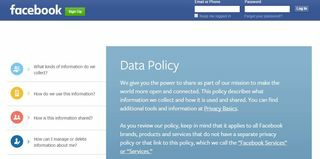 A Wall Street Journal article describes how some progressive Internet companies are simplifying language in their privacy policies. Although most of us click through and "accept" policies to get to the page we want, some read them carefully. Increasing concerns about data use and information sharing has affected how people use some sites. According to a Pew study, most mobile app users didn't download at least one app because of personal information that would be collected.
A Wall Street Journal article describes how some progressive Internet companies are simplifying language in their privacy policies. Although most of us click through and "accept" policies to get to the page we want, some read them carefully. Increasing concerns about data use and information sharing has affected how people use some sites. According to a Pew study, most mobile app users didn't download at least one app because of personal information that would be collected.
The article further explains the move towards plain language:
"The effort to simplify privacy policy language is a response to public suspicion of opaque policies and the collection of ever more data, said Fatemeh Khatibloo, a Forrester Research Inc. analyst who studies privacy. Some companies "are finally getting on board with the idea that privacy - and how they use our data - is closely tied to trustworthiness," she said. In addition, they're trying to write policies that will be viewed favorably in Europe, which has set a higher bar than the U.S. for what counts as consent to use personal data."
A good example of a privacy policy is from the Plain Language Institute. This group's mission is to improve government communications. However, the Plain Language website is simple, and the group doesn't benefit from sharing information. Pinterest, Facebook, and other social media sites need to collect user data to improve user experience and garner advertising revenue.
This reminds me of our U.S. tax code: it's complex. Trying to simplify information too much may not serve users in the end.
We know that Facebook has struggled with its privacy policy since the network's inception. People never seem happy with it, and continuous changes to the policy and settings frustrate everyone.
Discussion Starters:
- Look at a few privacy policies for your favorite websites. How easily do you understand what's written?
- Compare policies for static sites, such as news portals, and interactive sites, such as social networks. What additional information are the social networks trying to cover?
Twitter Updates Rules Again
 After criticism that Twitter needs to do more to prevent ISIS from recruiting and spreading hate, the company has updated its site rules. ISIS managed more than 46,000 Twitter accounts between September and December of 2014. Twitter rules are categorized as Content Boundaries and Use of Twitter, Abusive Behavior, and Spam.
After criticism that Twitter needs to do more to prevent ISIS from recruiting and spreading hate, the company has updated its site rules. ISIS managed more than 46,000 Twitter accounts between September and December of 2014. Twitter rules are categorized as Content Boundaries and Use of Twitter, Abusive Behavior, and Spam.
According to Reuters, Twitter "previously used a more generic warning that banned users from threatening or promoting 'violence against others.'" The new rules should make reporting and blocking new accounts easier. Under the subheading "Hateful Conduct," the rules specify,
"You may not promote violence against or directly attack or threaten other people on the basis of race, ethnicity, national origin, sexual orientation, gender, gender identity, religious affiliation, age, disability or disease."
In a blog post describing the change, Megan Cristina, Twitter's director of trust and safety, writes, "Keeping users safe requires a comprehensive and balanced approach where everyone plays a role." Cristina also explains, "We believe that protection from abuse and harassment is a vital part of empowering people to freely express themselves on Twitter."
Discussion Starters:
- Read Cristina's blog post. How well does she describe the change and Twitter's ongoing commitment?
- Is the company doing enough? How much responsibility should Twitter have for "hateful conduct" on its site?
Resume Heat Map: How Recruiters Spend Their Six Seconds
TheLadders tracked recruiters' eye movements when reviewing resumes. Using a heat map, we can see what this group looked at in the mere six seconds they spent reviewing your life's work.
Business Insider posted a video explaining the results. The biggest lesson is that your current and previous positions and education should be clear and easy to see. White space and font size matter.
What can we learn from the results?
- Recruiters scan the name and then current and previous jobs. Jobs should be prevalent under a section called Professional Experience or Work Experience. The results reinforce that you should highlight positions clearly with font enhancements, such as bold type. Also, this may be another case for taking positions with well-known companies. Then, consider how easily your position title can be read.
- Education was the next section scanned in the resume. Again, the name of a school and degree should be prominent in this section.
- What about other skills, volunteer work, etc.? These should still be included for the next round of the selection process: a second screen or an interview. But, as we already know, these can be placed at the bottom of the resume and shouldn't take up too much space. If you're debating between including your model airplane hobby and providing a bit more white space and a longer font, I'd go with the latter.
Discussion Starters:
- How can a recruiter assess your qualifications in just six seconds? Try to explain this from a hiring manager's perspective.
- What does this heat map tell you about your own resume? What changes will you make as a result?
Ted Cruz's Daughters as Monkeys: "Fair Game"?
The Washington Post has retracted a cartoon depicting presidential candidate Ted Cruz's children as monkeys.
The cartoonist, Pulitzer Prize winner Ann Telnaes, defended her cartoon:
There is an unspoken rule in editorial cartooning that a politician's children are off-limits. People don't get to choose their family members so obviously it's unfair to ridicule kids for their parent's behavior while in office or on the campaign trail- besides, they're children. There are plenty of adults in the political world who act childish, so there is no need for an editorial cartoonist to target actual children.
I've kept to that rule, except when the children are adults themselves or choose to indulge in grown-up activities (as the Bush twins did during the George W Bush presidency). But when a politician uses his children as political props, as Ted Cruz recently did in his Christmas parody video in which his eldest daughter read (with her father's dramatic flourish) a passage of an edited Christmas classic, then I figure they are fair game.
However, The Post editor Fred Hiatt disagreed:
It's generally been the policy of our editorial section to leave children out of it. I failed to look at this cartoon before it was published. I understand why Ann thought an exception to the policy was warranted in this case, but I do not agree.
The controversy may have given Cruz's campaign a nice Christmas jolt: so far, his family video has been watched more than 1.7 million times.
Is any publicity good publicity? That hasn't always held true on social media, but in this case, it's working in the candidate's favor.
And because it's Christmas, I'm reminded of Mike Huckabee's video in 2007. Some didn't appreciate the rather obvious window-pane-as-cross.
Discussion Starters:
- What's your view? Was the cartoonist justified in including Cruz's children?
- Was The Washington Post editor right? Should he have defied the cartoonist's position?
Best Graphics of 2015
 Bloomberg Business selected its favorite graphics from 2015. My favorites are still the bubble charts, if only because they are easy for students to create. Microsoft explains how to create bubble charts in Excel here.
Bloomberg Business selected its favorite graphics from 2015. My favorites are still the bubble charts, if only because they are easy for students to create. Microsoft explains how to create bubble charts in Excel here.
As is typical, this example shows different colors as variables and different sizes for, in this case, how many millions Swiss banks paid in penalties. (If you're wondering, BSI SA paid the most: $211 million.)
The New York Times also published its list of best graphics from 2015, including this interactive visual showing the impact of the recession on 255 industries.
Discussion Starters:
- Create a bubble chart with Microsoft's instructions. You'll also find YouTube videos to help. How does it turn out? For what type of information or presentation would you choose this chart option?
- Look at the detail behind the recession visual: so much information in one graphic! Do you find it useful, overwhelming, or something in between? What's the best way to navigate a visual like this?
Behind the Scenes of Caitlyn Jenner's Announcement
 It's hard enough for companies to announce organizational changes, but Caitlyn Jenner had a real challenge ahead of her. An interesting New York Times article describes the publicist and process behind Caitlyn Jenner's announcement that she is transgender and planned to transition.
It's hard enough for companies to announce organizational changes, but Caitlyn Jenner had a real challenge ahead of her. An interesting New York Times article describes the publicist and process behind Caitlyn Jenner's announcement that she is transgender and planned to transition.
Alan Nierob managed her announcement but prefers to stay out of the limelight himself. What's useful for business communicators is to understand his decision process: what was the best way for Jenner to announce her transition? Here are the options described in the Times article:
- "Keeping Up With the Kardashians": At the time, Jenner was on this E! television show, but Neirob worried it would look too "self-serving," and they questioned the loyalty of the family and network to represent the story well.
- Interview with NBCUniversal: Nierob rejected this plan as too corporate and seemingly financially motivated.
- Interview with Diane Sawyer of ABC News: Nierob trusted Sawyer and ultimately chose this as one of the options.
- Interview with Vanity Fair: This was Neirob's additional plan for people to understand Jenner's life and to see glamorous photos.
Reporters seem to respect Nierob's work. Here's a great description of an alternative to saying "no comment," which typically doesn't go over well. This is Nierob's response to questions about Mel Gibson's "blaming Jews for all the world's wars"(!):
"What I remember," said Jeff Jensen, a reporter for Entertainment Weekly assigned to write about Mr. Gibson's saga, "is that Alan respected our inquiry without participating. It was like: ‘I know this is a story, I know you have a job to do, and I wish you well, but I can't help, and Mel won't comment.' It was incredibly gracious and professional. He did his job for his client while showing respect for mine."
Discussion Starters:
- How could an interview with NBCUniversal look "corporate"? Explain how this might be perceived and how it could reflect negatively on Jenner.
- What if Jenner had described her transition on the Kardashian show? Describe potential positive and negative outcomes.
- Why is "no comment" a poor response to a reporter's question? What alternatives could work better?
12 "Synergies" Too Many in DuPont-Dow Announcement
The DuPont-Dow merger is big news with a big press release and two extremely long quotations. The statement uses "synergies" or "synergistic" 12 times.
PR Daily criticizes the release as "jargon laden" and presents as evidence this 140-word (not character) statement from the chairman and CEO of Dupont:
"This is an extraordinary opportunity to deliver long-term, sustainable shareholder value through the combination of two highly complementary global leaders and the creation of three strong, focused, industry-leading businesses. Each of these businesses will be able to allocate capital more effectively, apply its powerful innovation more productively, and extend its value-added products and solutions to more customers worldwide," said Edward D. Breen, chairman and chief executive officer of DuPont. "For DuPont, this is a definitive leap forward on our path to higher growth and higher value. This merger of equals will create significant near-term value through substantial cost synergies and additional upside from growth synergies. Longer term, the three-way split we intend to pursue is expected to unlock even greater value for shareholders and customers and more opportunity for employees as each business will be a leader in attractive segments where global challenges are driving demand for these businesses' distinctive offerings."
A close second, Dow's leader offered his own 111-word statement, which I'll refrain from pasting here. (You get the point from the first one.)
The press release follows the format of other, newer versions, which provide a bulleted list of main points up front for busy journalists. The headings also work well for skim-value.
Of course, the bigger issue may be the business decision itself. Steven Davidoff Solomon, professor of law at the University of California, Berkeley, questions a merger with a planned spinoff. He cites lots of research to tell us that spinoffs don't work in the long-run.
Discussion Starters:
- How could you simplify the press release? Try to omit all 12 instances of synergy/synergistic.
- An argument can be made that this is intended for a more technical audience of investors who expect jargon. What do you think?






